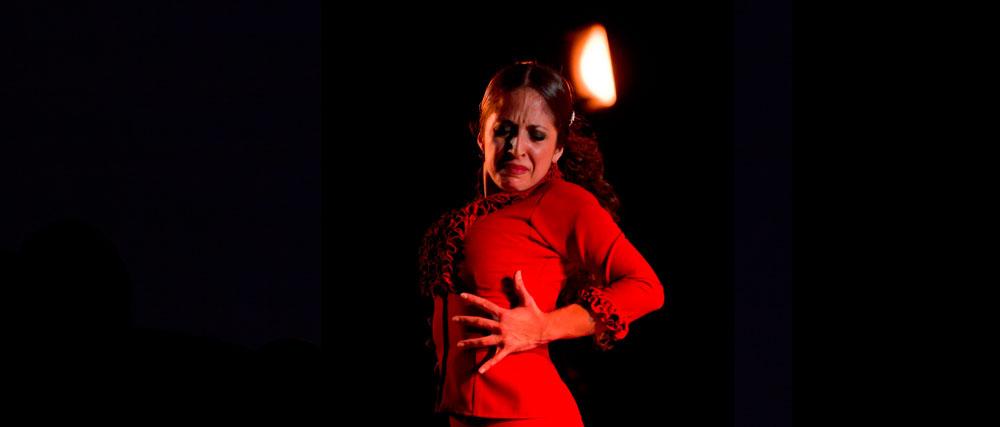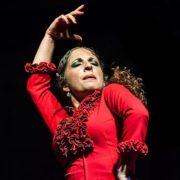Lidón Patiño
Graduated by the Professional Dance Conservatory of Madrid. Formed by the hand of great flamenco figures. She has worked in companies like Lola Greco. Soloist in several companies such as Rafael Amargo, José Huertas and Marta Fernández, and in the great show “De flamencas” by Marco Flores, among others.
In 2011 she is awarded the first prize of flamenco in the International Competition of Dance of Almería, and, at the end of that year, is awarded as Young Promise of Flamenco in the XX Contest of Spanish Dance and Flamenco of Madrid.
She has presented her own shows at prestigious festivals such as Suma Flamenca of Madrid, where she premiered “Reflejo“, and the Festival de Jerez, where she took the show “Flamenco”. She was also part of the Festival of New Flamenco Values XI Larachí Flamenca, premiering her show in Seville and taking it to Paris and Turkey.
In April 2013 she traveled to Japan with Enrique “El Extremeño” and shared the stage with exceptional artists such as Juan de Juan, Jesús Carmona, La Moneta, Carmen la Talegona, Luis de Luis, Soraya Clavijo, Karime Amaya and Farruco for the Flamenco Festival in Japan 2013.

She has taught flamenco courses in different countries of the world, and during her stays in Madrid she teaches intensive courses at the prestigious flamenco school Amor de Dios.
In Madrid she works in tablaos such as Las Carboneras, Casa Patas, Villa Rosa, El Corral de la Morería, El Café de Chinitas, among others.
She is currently one of the components of the renowned fusion band Patáx, with which she has toured the best jazz festivals, traveling to countries like USA, Lithuania, France, Costa Rica, Brazil, Peru, Portugal, Poland, Czech Republic, Germany and Morocco.
Interview Lidón Patiño
«As for my training, what I would highlight is that I trained with a lot of people because in Castellón there was an audition-contest every summer and, if you competed, they awarded you a scholarship. From the first year that it started, when I was 13-14 years old, I applied and I won several very good scholarships that allowed me to come to Madrid, for the first time. The courses were not only flamenco, but also classical, stylized and flamenco dance, of course. Another year they sent me to Jerez and another to the Foundation, to Seville. That is, I had the opportunity to learn with great teachers and a lot of variety of them. I have to emphasize that with whom I studied more in the last years of my studies at the Conservatory in Madrid and in a personalized way was with Carmen La Talegona, of whom I was her student. But not only because she taught me in the classes but because she is a friend apart and we shared many times together and I learned a lot from watching her dance, from knowing her dance a lot and seeing how she used it. I learned a lot from Carmen. There came a time when we both went to study and take things out together. So the mixture of respect for that artist and wanting to improve, made me very creative.
»There was a before and after in my career when I started working with Marco Flores. Before, when I thought that I could not work in any company due to my small stature, which is not the stereotype of a company bailaora, I joined the company of Rafael Amargo as a soloist. I had previously worked with Lola Greco and with Marta Fernández y José Huertas, which was the first company in which I was a soloist. But the before and after was with Marco, which for me was very important in my life because it was a single production and a season, but we toured the whole world. I learned a lot from him, from being able to dance by his side … I could not express it with words, but he gave me so much at the artistic level and at a human and leadership level, how he led his company, which seemed spectacular to me. The truth is that it was a before and an after.
“Anecdote? In the Flamenco Festival of Japan where, by chance, I was scheduled in a poster in which we were five male dancers and five female dancers and all of them had been my idols, my teachers, people that I had been watching for years and that I saw super distant. I saw myself very small, but I learned a lot on that trip. We were Karime Amaya, La Talegona, Soraya Clavijo, La Moneta and me, women. And of men was El Farru, Juan de Juan, Jesús Carmona and Luis de Luis. So, for me it was like saying what the hell I’m doing here. But I keep it as an anecdote in the aspect that I learned so much by sharing with them! I learned a lot and, besides, I felt very comfortable with them and I liked the experience, I liked watching them dance behind the scenes every day. It was a very nice experience and it was a gift of those that gives you life and I value the opportunity of being there.
»For me, dancing in a tablao is a mixture of much, much, much respect and constant self-improvement. It’s like the test of fire, there you see what you are as an artist. For me it’s a challenge every day that you get on a tablao, you have to get the best out of you, you have to be skillful in the response dancing and I think that dancing in a tablao makes us dancers be more knowledgeable every day a little more. Although I think you never stop learning in this and less in a tablao. In a tablao one is constantly learning. For me it is an honor and it is an honor to be in Las Carboneras, which is one of my favorite venues, where I feel most comfortable and it is an honor that you have me because I really enjoy it».






